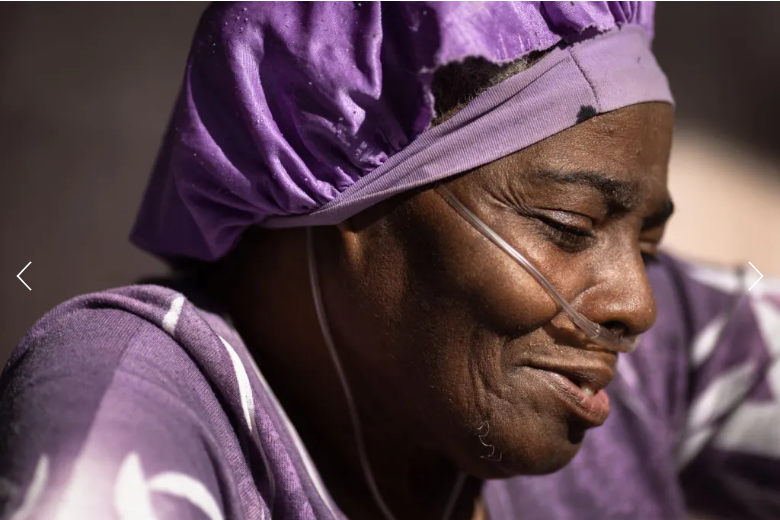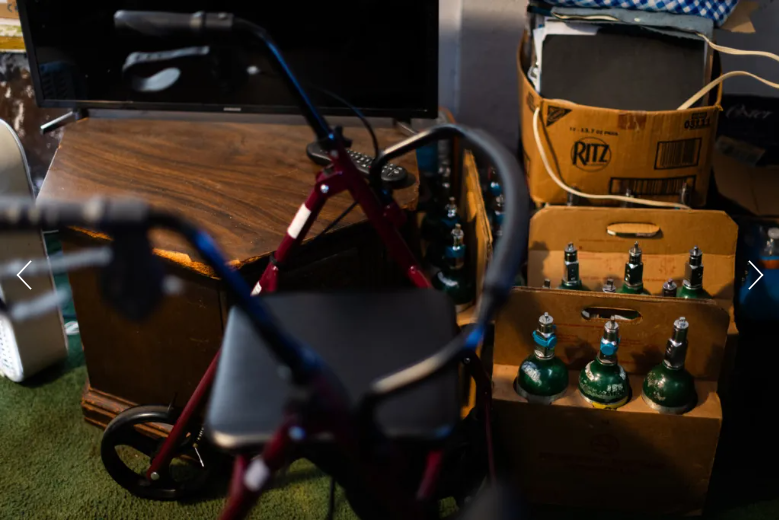She fell through all the cracks. Now, finally, her Harvey-damaged home will be rebuilt.
Jessie Jacobs is the picture of resilience. It’s late morning, and she’s sitting on her porch, turning her head to the early December sun the way a flower leans into that same glow. She twirls the four-leaf clover I’d just plucked from her backyard in her fingers, and smiles through her words. The front door is open behind her, letting the fresh air into her dim living room, and ensuring the doorframe won’t crimp the ever-present tubes from her oxygen tank as they snake through the house, onto the porch, and into her nose.
Soon, this porch will be gone. After years living with its rickety boards, and raggedy-edged bottom no longer able to hide years of rot that set in from the catastrophic damage suffered during Hurricane Harvey, Jacobs is — finally — a top priority for the state of Texas. Her home will soon be rebuilt by the Texas General Land Office (GLO), which is expediting the project so Jacobs and her little house can receive the attention they need before the holidays.
It’s been a long, often frustrating journey to make it to this point. She’s been denied assistance from FEMA, and missed out on earlier funding and rehabilitation opportunities due to miscommunications and paperwork issues. But Jacobs has refused to give up. Instead she has continued to do what this woman does better than just about any person I’ve ever met in my life:
“I’ve just kept faith,” she says.
I first met Jacobs in June, when we volleyed missed phone calls at each other before finally meeting in person. I was writing then about the limitations of resilience — how the hope implied by the word can be twisted until it becomes mandatory homework we assign to people who’ve been knocked down, rather than offering them a hand. Resilience, I wrote in my July column, has become an excuse or an absolution rather than a promise.

Of course resilience is exhausting, Jacobs told me then. But even after the 73-year-old Acres Homes resident had slipped through so many cracks in the social safety net that it looked like a freefall, she continued to press the importance of being resilient.
Resilience and faith, she says, are like weathering a storm. “Has there ever been a time the sun didn’t return?” Jacobs asks.
After Harvey damaged her home, Jacobs reached out for help, and none came. The first time I sat across from the black-topped fold-up card table in the center of Jacobs’ dining room, she thumbed through stacks of manila folders, containing FEMA denial letters and contracts showing that her siblings had signed over ownership of her beloved but increasingly moldy house to her after her parents’ death. She assembled a paper trail of all the ways she’d tried to access public funds made available to Houstonians whose houses desperately needed repair after Harvey. They’d all been dead ends.
I copied the hand-scrawled phone numbers from torn sheets of paper.
I’ll make some calls, I promised. Ask some questions. See what I could learn.
I spent the next few weeks in a maze of emails and phone calls with the city, the state and nonprofit organizations that work to help people in situations like Jacobs’. I refused to take voicemail for an answer. I had her sign an affidavit so government entities could release information about her, and returned to her house with updates. And along the way, I found several public servants who, upon hearing Jacobs’ story, went beyond what their jobs call them to do. (Non-profit workers were also key; when Jacobs told me in November that the cost of one of her medications had soared to $400 a bottle, I reached out to folks I’d met at Civic Heart, while writing about the Medicaid unwinding for help. One phone tree later, Jacobs’ pills are once again fully covered.)






